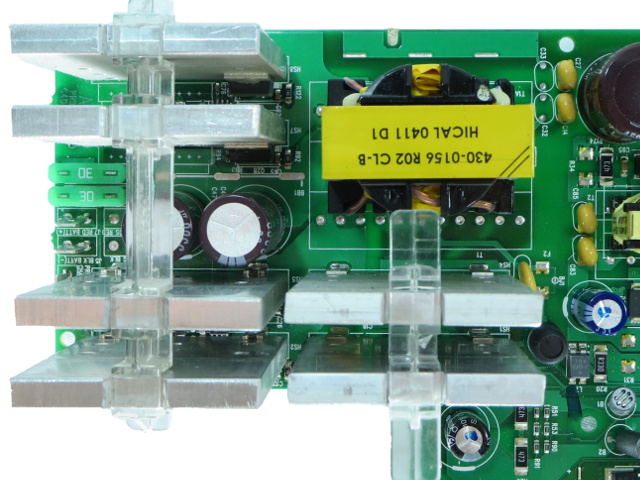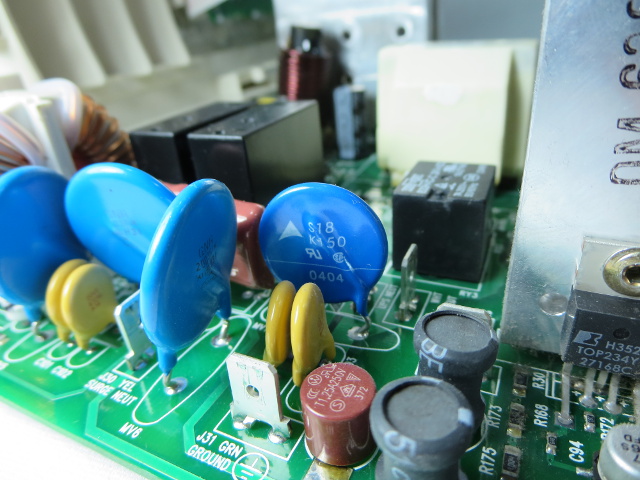Tear-Down: Let's Take a Trip Inside A UPS
In response to our power bar tear-down, many of you asked to see a UPS receive the same treatment. So, today, we go on a tour inside a vintage APC BX1000.
The Brawn
Here are those six aluminum plates and transformer again. Each of the plates on the left carries a lone IRF3205 HexFET device rated for 55 V and 110 A driven by IR4427S dual MOSFETs controlled by a MicroSemi 3525ADW pulse-width modulator located half-way across the board — you can see it in the bottom-left corner of slide 17. Devices on the plates to the right have two pins each, giving them away as diodes, and the board's copper artwork says they are in a full-bridge configuration. Rectifiers on the front plate are hidden under a riveted steel clamp, but the second row showcases OnSemi U820 markings, which is short-hand for MUR820 rated as ultra-fast rectifiers for 600 V and 8 A. Near the bottom-right corner, we have the rectifier bridge's 22 µF 200 V output capacitor and a pair of 470 kΩ resistors in series providing 940 kΩ of bleeder resistance.
Nestled between the four left heat sinks are the battery spade terminals, a pair of 35 V 2200 uF capacitors (to decouple high-frequency switching ripple from the batteries), and a pair of 30 A fuses in parallel configuration for 60 A combined rating (to accommodate the 50+ amperes the UPS may draw from its 24 V battery pack under full 1000 VA load).
If you have not guessed already, this circuit configuration is a 1000 W peak battery-voltage to 160+ VDC step-up converter. I could fire it up to make actual measurements, but guessing is much safer than poking around with the board upside down — that is, assuming the UPS would even work with everything else unplugged.
The Last Stop
This is what a "modified sine wave" output looks like from a PCB layout point of view: ~160 VDC comes in from the step-up converter through the fat traces at the top-left, pass under a large Falco-branded inductor, gets decoupled by another capacitor before reaching the UPS' six output MOSFETs—one IRF640 rated for 9 A and 200 V with 350 mΩ RDSON, along two PHP20NQ20T rated for 20 A and 200 V with 120 mΩ RDSON on each heat sink. All of these MOSFETs are driven by a trio of IR2101S dual independent high-side-low-side drivers, which are, in turn, controlled directly by the micro-controller. The MOSFETs' output passes through the largish inductor near the upper-right corner, and then the yellow current-sensing transformer, before reaching the output.
Since driving a modified square wave should only require four switching devices, you may wonder where the two weaker IRF devices fit in. After following the traces, it appears the two IRFs are actually there to switch that Falco inductor in and "snub" inductive load current from the high-side devices as they turn on or off. In-circuit observation with an oscilloscope would be necessary to find out exactly what the drive sequence is. At the very least, the IRFs are definitely related to the Falco inductor, since they form a half-bridge driving one of its two terminals and nothing else.
Trick Shots
Managing to get part numbers off those second-row TO-220s was more challenging than it sounds. I could not do it by eye due to extremely shallow angles. But after some trial and error with my camera and lighting, I managed to get readable shots without seriously straining my vision. The U820's markings were particularly difficult to get, with the laser etching disappearing under the tiniest amount of dust until I found the right lighting angle to make it somewhat readable.
An Oldie But Goodie
For a 10-year-old UPS, this BX1000 has held up quite well. Aside from some discoloration around the KA7812 and the soot-like residue that accumulated behind it, the rest of the board and its components still look good-as-new after a little bit of cleaning. The unit would likely also work good-as-new if I got a pair of replacement batteries that met or exceeded OEM specifications instead of grabbing the most convenient things that fit.
Get Tom's Hardware's best news and in-depth reviews, straight to your inbox.
To end this story, here's a nice picture of shiny, candy-colored components I ended up not using elsewhere. You can see how APC labeled spades with a header identifier, wire color, and function, along with the TOP234Y riveted to its heat sink.
-
blackmagnum Thanks Daniel for the interesting write up of this old beauty. I have always trusted APC for my electricity supply backups.Reply -
olsaltydog Good article, I find it funny you just put this up. I just turned in a 8 page research paper on UPS systems and the potential technology that could replace the traditional lead-acid UPS/ Diesel Generator combination. Could have used you in part of my paper for a citation.Reply -
Daniel Sauvageau Reply
I actually sent in this article two weeks ago. It just happened to finish bubbling up the editorial pipeline last weekend and get a publication slot today.14138873 said:Good article, I find it funny you just put this up. I just turned in a 8 page research paper on UPS systems and the potential technology that could replace the traditional lead-acid UPS/ Diesel Generator combination. Could have used you in part of my paper for a citation.
As for replacements for the good old UPS + Generator combo, I presume you mean things like the Bloom Box - basically a fuel-cell-powered UPS - removes the lead, the acid, periodic battery replacement, periodic maintenance on the mechanical parts, etc. from the equation. -
olsaltydog Yeah one portion of the paper dealt with the Bloom Box being implemented and used by Microsoft, E-bay, and Apple. Another part of the paper was about just replacing the lead acid batteries themselves with the Durathon battery design created by GE. Only thing is GE's battery will be used in larger applications just like the Bloom Box. The last portion I researched was how Hybrid topologies where essentially a combination of of the Star and Bus/Ring topologies you could essentially create a new entire category of UPS' by integrating the UPS into the generator itself.Reply
Im just glad the paper is done and the UPS's we have at work dont need their batteries replaced hopefully for another few years. The ones we are using have a tray of about 20-26 batteries linked together and can make a great sparkler if the terminals make contacts to the wrong parts. -
f-14 ReplyHaving trouble unlocking your "slightly used" UPS to take a look inside? At the top of the BX1000, there is a snap about halfway in at the top holding the shell's two halves together. Its location is circled in red on this picture. You need a long, flat screwdriver to easily reach and disengage it.
or go to your utensil draw and grab those chop sticks you've been saving! -
rahulkmr391 i have a APC Back UPS RS600 which i purchased in june 2011 and its battery has been replaced on april of 2014 it worked fine till august of 2014 suddenly it it stated to give me problems it was refusing to start up but battery power was working but it refuses to supply power to my equipment when i asked tech support they said the main Board has to be changed the reason they said to me is fluctuation killed my ups. what an utter piece of junk, my older ups served me for about 9 years with regular battery changes but the apc one died in less than 3yrs is this what apc makes quality ups..?Reply -
olsaltydog So you had one failure with how many long lasting APC UPS' out there. UPS' have many parts that can wear or fail at some point and should not be looked at as the ultimate safeguard. They can fail and most people find that out when they need it not to. I know it sucks but this one instance you had with APC probably should not deter you from their product. Check online if the model has been having issues then yeah avoid it, no different then what we do with power supplies which is a good reason there is a list here on site. Other then that I have seen many types of there products hold strong and true for years, hope your next experience even if with another company goes better.Reply



